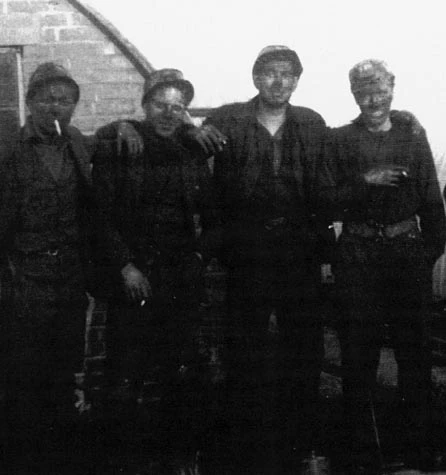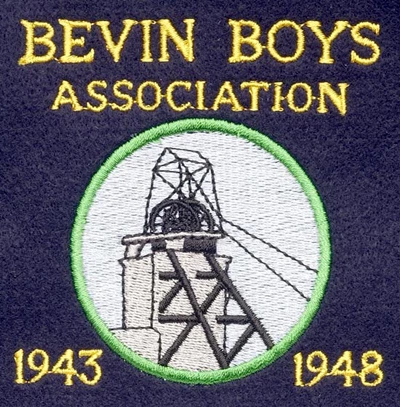Remembering the Bevin Boys in the Second World War
Bevin Boys commemorative banner
Bevin Boys from South Wales
Bevin Boys Association blazer badge.
A retired pit pony poses with two former Bevin Boys at the annual reunion at Trentham Gardens, Stoke-on-Trent.
Former Bevin Boys attending the Remembrance Parade in London on the 14th November 2004
The underground front
The story of the Bevin Boys miners has been largely untold; those many men who spent their war on the so-called 'underground front' went unrecognized for almost half a century.
When Britain declared war in 1939, thousands of experienced miners left the mines to join the armed services or transfer to higher-paid 'war industries'. By the summer of 1943 over 36,000 men had left the
coal industry . The British government decided that it needed around 40,000 men to take their places.Ernest Bevin
In December 1943, Ernest Bevin, the wartime Minister of Labour and National Service, devised a scheme whereby a ballot took place to put a proportion of conscripted men into the collieries rather than the armed services. Every month, ten numbers were placed in a hat; two numbers were drawn out, and those whose National Service registration number ended with those numbers were directed to the mining industry.
These "ballotees" became known as "Bevin Boys".
Alongside the ballotees were the "optants", men who had volunteered for service in the coal mines rather than the armed services. Between 1943 and 1948, 48,000 young men were conscripted for National Service Employment in British coal mines. Contrary to a common belief at the time, only 41 of them were conscientious objectors.
Bevin Boys, therefore, came from all social classes and regions in Britain, not just the mining areas. Many had only been vaguely aware of the mining industry before being drafted. Most had set their sights on a career in the armed services and were horrified to be sent to the collieries instead.
Punishment
In April 1944 the Colliery Guardian reported that 135 ballotees had been prosecuted for failing to comply with the direct labour order. Thirty two went to prison, although 19 of them were released when they eventually agreed to go into the mining industry.
Picks and shovels
Unlike the ordinary miners, who wore their own clothes, Bevin Boys were issued with overalls, safety helmet and working boots. However, they still had to pay for their own tools and equipment, which led to complaints that the infantry were not expected to supply their own rifles so why were they expected to buy picks and shovels!
Only a small proportion of Bevin Boys were actually employed cutting coal on the coal face, although some worked as colliers' assistants filling tubs or drams. The majority worked on the maintenance of haulage roads, or generally controlled the movement of underground transport. A small number who had previous electrical or engineering experience were given similar work in the collieries.
Bevin Boys suffered from resentment from local mining families who had seen their own children drafted into the armed services only to be replaced by "outsiders". In addition, just being young men out of uniform could lead to abuse from the public or attention from the police as possible deserters, "army dodgers" or even enemy spies. It is not surprising that they suffered from high absentee rates. A very small number stayed in mining after the war, but most couldn't wait to leave.
Official records destroyed
The ballots were suspended in May 1945, with the last Bevin Boys being demobbed in 1948. Unlike other conscripts, they had no right to go back to their previous occupations, they received no service medals, "demob" suit or even a letter of thanks. Because the official records were destroyed in the 1950s, former Bevin Boy ballotees cannot even prove their service unless they have kept their personal documents.
The first official Bevin Boys reunion was held at the former Chatterley Whitfield Mining Museum in 1989. More have been held at various venues since then. However, it was not until 1995, 50 years after Victory in Europe Day, that the British government finally recognized their service to the war effort and former Bevin Boys are now officially allowed to take part in the Remembrance Day service at Whitehall.
For any information on the Bevin Boys Association please contact:
Warwick H Taylor, Vice President, Bevin Boys Association, 1 Rundlestone Court, Dorchester
Dorset, DT1 3TN





Comments - (27)
Sadly died this year in October 2021 aged 95
He was so humble especially about his time down the mine.”I had a job to do and I just got on with it”
I believe there is now only 69 Bevin Boys left.
We were proud of my dads service down the mine.
Big thank you to all the Bevin Boys who were unsung heroes in my eyes.
Roy Thomson
Wirral, merseyside
Thank you very much for your enquiry. We don't have lists of Welsh based Bevin Boys, I'd recommend that you contact the Bevin Boys Association, whose contact details can be found on their website http://www.bevinboysassociation.co.uk/.
Best wishes
Ceri Thompson
Curator, Big Pit: National Coal Museum
John Thompson from Glasgow ( Jock ) taught me how to use a pick and shovel.
If you started him digging in the morning you had to stop him at tea time.
Lovely lovely man.
Always remembered.
Hi Kenneth,
When completed in 1881 the shafts at Ashton Moss were the deepest in the country, working the Six Foot Mine at 846 metres and the Four Foot (Black) Mine at 878 metres deep. This was beyond the limits then believed possible. Coal winding began in May 1882.
Apparently ‘the Colonel’ was being worked during the 1940s, but I don’t know if this was a local name for a seam or just a district underground.
If you get in touch with The English Coal Mining Museum in Wakefield, Yorkshire, they may have much more information.
Best wishes,
Ceri
Dear Kenneth Oakes,
Thank you very much for your enquiry. We recommend that you contact the Bevin Boys Association, whose contact details can be found on their website http://www.bevinboysassociation.co.uk/.
Best wishes,
Marc
Digital Team
Half years great pals Thomas YSTRAD MYNACH